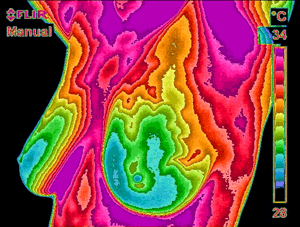Thermal (infrared) imaging for breast cancer screening seems to me to be a fantastic, SQUISH-free method of discovering whether something diabolical is happening within the breast. When I lived in Australia, there was a top-notch thermal imaging facility that I attended every year after my diagnosis of breast cancer (wish I’d gone before!).
Current research indicates that 1 in every 8 women in the US will get breast cancer in their lifetime, sobering statistics.
While mammography, ultrasound, MRI, and other breast imaging devices rely primarily on finding a physical tumor, thermal imaging detects the heat produced by increased blood vessel circulation and metabolic changes associated with a tumor’s genesis and growth (called neoangiogenesis). By detecting tiny variations in normal blood vessel activity, infrared imaging may find thermal anomalies suggesting a pre-cancerous state of the breast or the presence of an early tumor that is not yet large enough to be detected by physical examination, mammography, or other types of structural imaging.
Thermal imaging uses ultra-sensitive medical infrared cameras and sophisticated computers to detect, analyze, and produce high-resolution images of these temperature variations (see photo above).
The extreme sensitivity of thermal imaging may be the best device for indications of neoangiogenesis and a developing tumor. And as we know, early detection means LIFE.
According to breastthermography.com, “Studies show that an abnormal infrared image is the single most important marker of high risk for developing breast cancer, 10 times more significant than a family history of the disease (P. Haehnel, M.D., M. Gautherie, Ph.D. et al; Long-Term Assessment of Breast Cancer Risk by Thermal Imaging. In: Biomedical Thermology, 1980; 279-301)” (bold type added by me).
Better yet, it doesn’t hurt! Unfortunately, the medical profession as a whole still hasn’t completely accepted thermal imaging and few insurance companies will cover the cost of it, at least in the USA. The average fee for first-time patients is around $300. Be that as it may, I believe it’s a very good method for discovering problems early on and well worth the price, especially if you consider yourself in a high risk category or have found a breast lump that ordinary mammography hasn’t picked up.
If you’d like to stay connected, sign up for my free e-newsletters on the right, or “like” me on Facebook (Marnie Clark, Breast Health Coach) and I’ll do my utmost to keep you informed and empowered on your healing journey… and beyond.




Trackbacks/Pingbacks